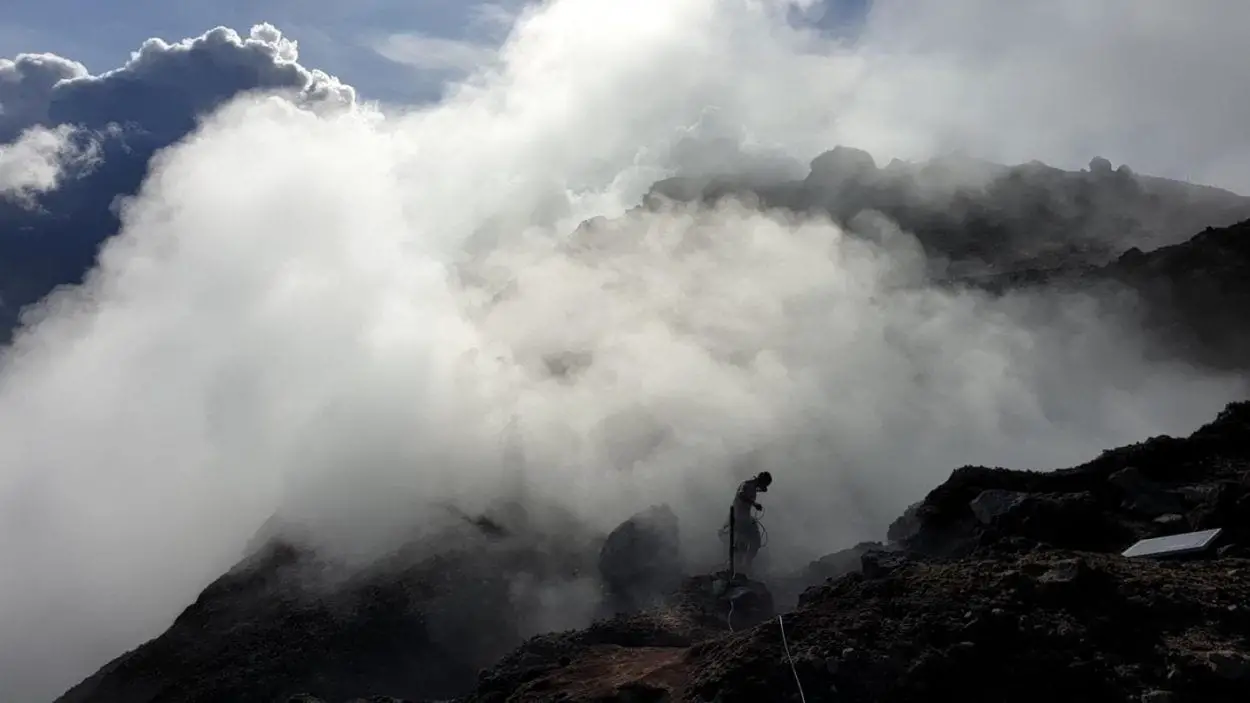The heights of La Soufrière de Guadeloupe volcano can be hellish, sweltering at more than 48 degrees Celsius (120 degrees Fahrenheit) and swathed in billows of acidic gas.
Researchers would like to monitor gas and steam eruptions at its summit, to learn more about the volcano’s explosive potential, but conventional seismometers are destroyed quickly in the hostile environment.
An instrument called an optical seismometer appears to be up to the challenge, however. In the journal Seismological Research Letters, a team of scientists describes how they developed and installed an optical seismometer just ten meters away from a spewing fumarole (a gas and steam vent) at the Caribbean volcano’s summit.
The motion of the optical seismometer (and therefore of the ground) is estimated using an interference phenomenon, which occurs when an infrared laser beam is reflected by the mirrored surface of the seismometer mobile mass. This laser beam is carried between the seismometer at the summit and a remote and safe optoelectronic station through a long fiber optic cable, climbing the volcano’s slope. The station calculates the ground displacement and sends the records in real-time to the French Volcanological and Seismological Observatory of Guadeloupe.
The seismometer operates purely mechanically, and requires no electronics or power supply that would be vulnerable to the summit conditions, said Romain Feron, the paper’s lead author from the ESEO Group and the LAUM laboratory at the Université du Mans. The instrument is encased in Teflon to protect it from the sulfuric gases released by the fumarole.
“It is, to our knowledge, the first high-resolution optical seismometer ever installed on an active volcano or other hazardous zone,” Feron and colleagues write in SRL.
The success of the seismometer, after ten years of development, suggests that it could be a good seismic solution in other challenging environments, they noted, including oil and gas production fields, nuclear power plants and high-temperature geothermal reservoirs.
Now in operation on the volcano for nine months, the instrument is collecting data that will be combined with other observations from the Guadeloupe observatory to better monitor La Soufrière. The volcano’s last significant eruption of gas and steam in 1976 caused evacuations in Basse Terre, Guadeloupe’s capital city. Since 2018, the volcano’s dome and summit fumaroles have become increasingly active.
Seismic monitoring at volcanoes can help researchers understand the movement and pressurization of underground fluids. The new optical seismometer could provide better locations for microseismic events under the dome, and offers a more detailed glimpse of “the fumarole signature, which helps to constrain the geometry and activity of the plumbing system of the dome,” Feron said.
The instrument has recorded seismic waves from a regional earthquake, an earthquake in Chile, and small seismic events within the volcano less than 2.5 kilometers (1.6 miles) below the summit, the researchers reported.
Feron and colleagues made an arduous climb to La Soufrière’s 1,467-meter (4,813-foot) summit in September 2019 to install the seismometer, using gas masks to protect themselves from the toxic gases spewing from active fumaroles. In addition to the gases and high temperatures, the team needed to keep a close eye on the weather during the installation, Feron said.
“It could be beautiful at the bottom of the volcano, but hellish at the top at the same time,” he recalled. “It becomes very risky to climb the steep and slippery slopes of the volcano with heavy equipment on the back, not to mention lightning.”





